The Introduction of the Potato into Ireland
Published in Early Modern History (1500–1700), Early Modern History Social Perspectives, Features, Issue 1 (Spring 2001), Medieval History (pre-1500), Volume 9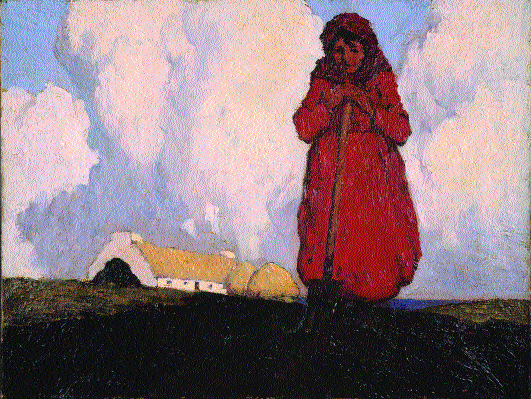
The Potato Digger by Paul Henry. (Ulster Museum)
Isn’t it ironic that the conquistadors of Spain, who first brought the potato to the attention of those outside the Americas, were relatively indifferent to the vegetative gold that they stumbled upon in the 1530s? They rode over the tubers, in pursuit of the Inca leader Atahualpa and his fabled riches. Little did they realise that, once introduced into Europe, the potato would begin more than four centuries of conquest. The ancient empires of South America have long since vanished. Europe’s imperial glory is only a distant memory. But the potato continues to thrive in Ireland and the world as a whole, expanding its consumption empire by the day. Despite the important role the potato was later to play in Irish history, we still don’t know how the potato reached our shores. Sir Walter Ralegh, Sir Francis Drake and John Hawkins, have all been credited with introducing the potato into Europe. Indeed, the early history of the potato is obscured by often contradictory stories, many of which can be relegated to the sphere of romance. So who did bring the potato to Ireland and when?
South American origins
It has been argued that the first potatoes brought to Europe came from Chile (subspecies tuberosum), because they had been adapted to form tubers in the long summer days of southern temperate latitudes and would feel at home in Europe where the day length was similar. In contrast, the potato found in Peru and Colombia (subspecies andigena) is adapted to the shorter days of tropical latitudes and does not tuberise in Europe until very late in the season when the natural day length has shortened to more or less twelve hours in late September and early October. Redcliffe Salaman writing in the 1940s was adamant that the length of time needed to transport potatoes to Spain from Chile would have resulted in the death of any tubers. The first journey from Chile to Europe via the Straits of Magellan was not made until 1579, when the potato was already known in Europe. It was therefore, he argued, the less favourable andigena that was brought to Europe from Colombia. Therein lies the dilemma, since it is not andigena that we see every day on our dinner tables, but tuberosum. So how did this happen?
Introduction into Europe
The first European potatoes were it seems antigena from Colombia (for most of Europe at least). They could only tuberise in the shorter days of the European autumn, and grow in milder regions of Ireland, Spain, Italy, etc.. We know this from the evidence provided by contemporary botanists. The Frenchman Charles d’Écluse, or Clusius (1526-1609), a central figure in the spread of the potato in Europe, in 1601 describes a plant with stems up to 7.5 feet (2.28m) and 10.5 feet (3.2m) long, while also noting that the plants were harvested in November. Swiss physician, anatomist and botanist Caspar Bauhin (1560-1624), writing in 1620, also mentions that the potato was harvested in November and his potato drawings are similar to the species andigena.
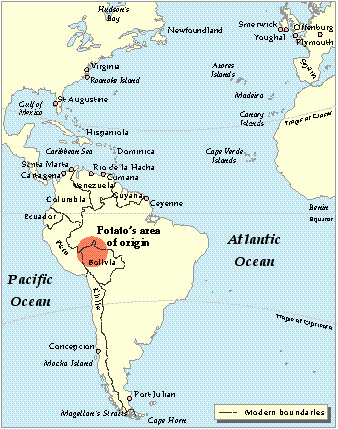
The sweet potato (ipomoea batatas) which is unrelated to the potato, grew in lowland areas all around the Caribbean, at the time of the Spanish conquests. The potato in contrast was only cultivated in the most inaccessible of places. The sweet potato was introduced into Spain almost immediately after the earliest voyages. King Henry VIII, son-in-law of King Ferdinand and Queen Isabella of Spain, was particularly fond of them believing they possessed aphrodisiac qualities, which could provide him with that all-elusive heir. The ‘venerous roots’, imported from Spain, were a popular feature of many English banquets during the sixteenth century. In Shakespeare’s The Merry Wives of Windsor, when Sir John Falstaff, thinking he is about to bed two women, cries ‘Let the sky rain potatoes’, he is more than likely referring to sweet potatoes. The sweet potato was not only more accessible but also exclusive, as it could only be grown in the climate of Spain. It therefore proved to be rare and expensive in the rest of Europe. John Hawkins (1532-1595), English naval administrator, commander and expert seaman also took aboard ‘hennes potatoes and pines’ at Santa Fé in Venezuela during 1564, but again given the location these must have been sweet potatoes.
Columbus and his men never saw a tuber of solanum tuberosum, nor did the conquistador Hernán Cortéz (1485-1547) encounter the plant in Mexico. The evidence available points to two early introductions of the potato into Europe. The first, into Spain about 1570 and the second into England between 1585-1590. The Hospital de la Sangre in Seville was buying potatoes as part of their housekeeping as early as 1573. This implies that potatoes were being grown in Spain for a number of years in order to build up stocks. Clusius had visited Spain in 1564 and studied many of the new plants, which had been brought from the New World, but he does not mention the potato. The potato must therefore have been introduced to Spain between 1565 and 1570.
John Gerard
It is not until the early 1590s that we hear of the potato in England. The English herbalist John Gerard (1545-1612), was indebted to Clusius for information regarding the potato. Gerard was a popular man who was often presented not only with rare plants and seeds from different parts of the world but also with offers to supervise the gardens of noblemen. Published in 1597, his celebrated Herball, or Generall Historie of Plantes, containing more than 1,000 species, became the first plant catalogue, and the first to incorporate a picture of the potato. It was immensely popular, providing more than 800 chapters of information on species as they were then understood. It also contained a large amount of folklore. In his Catalogue of 1599 Gerard added the term ‘bastard potatoes’ to distinguish the potato from the sweet potato, and added that he had received potatoes from their natural home, Virginia. He refers to the Indian name of the potato, which he incorrectly spelt ‘papus’. However, the name papas, was its vernacular not in Virginia, but in its original habitat in the South American Andes. Gerard’s statement in the Herball, that the potato had come from Virginia is erroneous. Although wild potatoes are found as far north as Nebraska in North America, no species was cultivated outside South America at the time the Spanish arrived in the New World. The potato as we know it was completely unknown in North America until the seventeenth century, and wasn’t cultivated there until the 1720s when introduced by settlers from Ulster. The potato could not therefore have been growing in Virginia as Gerard states.
Introduction into Ireland
The president of the Royal Society, Sir Robert Southwell (1635-1702) was recorded in the minutes of a meeting of 13 December, 1693 as stating that his grandfather had ‘brought potatoes into Ireland who had them from Sir Walter Rawleigh after his return from Virginia’. Sir Robert’s grandfather was Anthony Southwell (1579-1623), who with his brother Sir Thomas came to Munster in some official capacity in the reign of James I. Sir Robert’s grandfather and great-uncle were the sons of Richard Southwell of Spixworth in Norfolk and his wife Alice Cornwallis. They are recorded as holding land in Cork prior to 1609. However, Robert Southwell’s statement is rather dubious to say the least. If Ralegh was in a position to distribute potatoes at an early date, he must surely have got these potatoes from England, since he was never in Virginia and as already mentioned, Solanum tuberosum is not native to Virginia.
The confusion may arise due to Ralegh’s association with a number of voyages to North America. Under royal patent granted by Elizabeth I in 1584 to Ralegh, a group of colonists left for North America in April of that year, to map out a route and prepare the way for the main party, which was to follow. A second contingent of colonists was sent to North America, departing on 9 April 1585. In August 1585 the colonists arrived in what is now eastern North Carolina, in Dare County, in Croatan Sound. However, the first venture failed and the colonists returned to England in July 1586 with Sir Francis Drake who was returning after privateering in the West Indies. Further voyages were made in 1587 and 1590, but no subsequent attempt at colonising was made until 1606. In 1590 a voyage took place from England to the Americas which was partly financed by Ralegh. These ships brought back various Spanish ‘prize ships’ and also called at Virginia on the return to England. It is tempting to believe that potatoes came from these Spanish ships which had fallen into English hands. However, there is not a shred of evidence to support such an assumption. Ralegh gave up his patent in March 1590, having never set foot in Virginia. No mention whatsoever was made of potatoes on their return. So why then is Virginia associated with the introduction of the potato into Britain and Ireland?
Ralegh had sent his friend and colleague, English mathematician and astronomer, Thomas Harriot (1560-1621), as a scientific adviser for the expedition of 1585-86. On his return to England in 1588, Harriot published A Briefe and True Report of the New Found Land of Virginia. He mentions a stringy tuberous plant called the ‘openawk’, with which the potato has often been confused right up until the nineteenth century, hence the association of the potato with both Virginia and Ralegh. Ralegh evidently saw potatoes off the coast of Venezuela but these were undoubtedly sweet potatoes: Ralegh never went near any area where he might have found solanum tuberosum. He tried to visit Virginia on his return from his disastrous venture in Guyana in 1595, but failed. That Ralegh planted potatoes at his Myrtle Grove estate at Youghal, County Cork is probably more myth than fact.
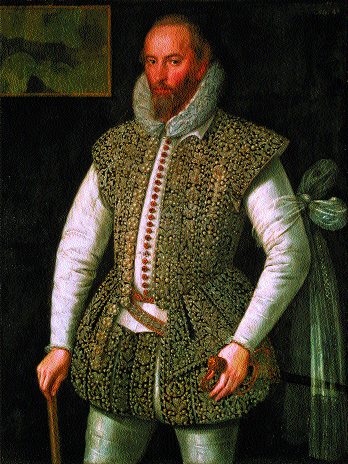
Sir Walter Ralegh-did he really introduce the potato to Ireland? (National Gallery of Ireland)
Of course the potato was known and its cultivation well understood in Munster at a very early date. Although Ralegh was mayor of Youghal in 1588-89, he didn’t spend much time in the country. As to Ralegh’s voyages, only one touched the coast of Ireland on the return journey, and that at Smerwick, County Kerry, with the crew half-starved. The Ralegh legend although dating to Southwell in 1693, was made popular by Dr Wright of Edinburgh, who credits Ralegh with the introduction in a letter he wrote to the English Board of Agriculture in 1795.
Sir Francis Drake
Sir Francis Drake (c.1540-96), unlike Ralegh, actually came into contact with solanum tuberosum in the Americas. Drake returned to Plymouth in August 1573 after several successful ventures against the Spanish, but had to put to sea again as the friends of Spain were just then in the ascendant at Elizabeth’s court. It is rather unlikely that Drake seized potatoes from the Spanish when there was more valuable cargo to be had, but the period after his return from South America in the autumn of 1573 is an obscure one in his life. While he did serve under the Earl of Essex in suppressing a rebellion in Ireland, he does not emerge into the clear light of history until two years later.
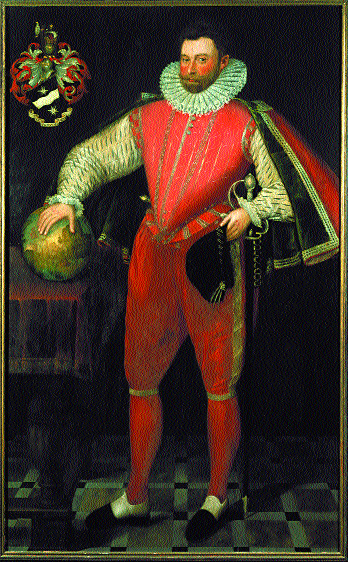
Sir Francis Drake-‘introducer of the potato into Europe, in the year of Our Lord 1580′ according to a monument in Offenburg, Germany. (National Portrait Gallery, London)
A spot in Cork harbour between Carrigaline and Crosshaven, where he is reputed to have landed is still known as Drake’s Pool. It seems improbable that the potato was introduced around this time as it had only just been introduced to Spain, whose conquistadors had known of its existence for more than a quarter century, and at a time when it was not yet known in England.
That Drake did later come into contact with the potato is undisputed. It is recorded in The World Encompassed (1628), that Drake obtained potatoes by barter from the Indians of the Islands of Mocha, off the coast of Chile in November 1578: ‘we being on land, the people came down to us to the water side with shew of great curtesie, bringing to us potatos, rootes and two very fat sheepe’. Drake did not return to Europe until 26 September, 1580, nearly two years later. It has since been proven by W.G. Burton in the 1980s, contrary to Salaman, that potatoes given only the slightest of care will sprout little tubers and survive in the most inhospitable of environments. Such tubers could well have been introduced as curiosities by Drake or one of his crew. Having completed his renowned second circumnavigation of the globe in November 1580, he was honoured by a visit from Queen Elizabeth I, who dined with him on board his ship, the Golden Hind (formerly the Pelican), which was lying at Deptford in the Thames estuary, but there is no record of potatoes appearing on the menu. Clusius visited Drake in 1581 and published articles the following year on some of Drake’s plants, but again there is no mention of the potato. Ironically, given Ralegh’s association with the potato down through the centuries, it was to Drake and not to him that a monument was dedicated in Offenburg, Germany, with the inscription: ‘Sir Francis Drake, introducer of the potato into Europe, in the year of our Lord 1580’.
If potatoes came from Virginia in 1586 they must already have been on Sir Francis Drakes’ ships and he may have acquired them from the sack of Cartagena on the coast of modern day Colombia. In 1585 Drake had been in command of twenty-five ships. Hostilities with Spain had broken out once more, and he was ordered to cause as much damage as possible to the Spanish overseas empire. Drake fulfilled his commission, capturing Santiago in the Cape Verde Islands and taking and plundering the cities of Cartagena, St Augustine in Florida, and San Domingo in Hispaniola. Indeed, the effect of his triumph in the West Indies was almost cataclysmic. Spanish credit, both moral and material, almost foundered under the losses. Potatoes may well have formed part of the valuable haul taken from Cartagena itself or from the cargoes of plundered ships. Drake left Cartagena on 30 March 1585, after picking up the colonists from the failed Roanoke settlement in Virginia, he arrived in Plymouth on 26 July 1586. These potatoes could in all likelihood have been confused with the plants from Virginia brought back by Harriot. Certainly this would reconcile a number of statements, although we can only speculate whether this actually happened.
Sir Thomas Cavendish
Drake was not the only Englishman to come into contact with the potato at an early date. On 16 March, 1587, Thomas Cavendish (1560-1592) English navigator and leader of the third circumnavigation of the globe, stopping at St Mary Island, near Concepción, southern Chile, found ‘cades of straw filled with potato rootes, which were very good to eat, ready made up in the storehouses for the Spaniards, against they should come for their tribute’. Clearly the Spanish had come to recognise the value of such a commodity. Here Cavendish and his crew took aboard supplies and ‘a number of bagges of potato rootes’. Ever since passing through the Straits of Magellan, Cavendish had attacked Spanish settlements and shipping from the Chilean coast up to Mexico. Among his prizes was the treasure galleon Santa Ann seized off California in November 1587. Cavendish like Drake returned to England around Cape Horn, and arrived in Plymouth on 9-10 September 1588, with only one of his ships, the Desire, and much plunder. Certainly Cavendish had ample opportunities to lay his hands on potatoes during his expedition, but whether he did actually bring back tubers among the proceeds of his exploits will probably never be known.
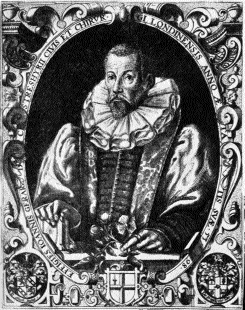
John Gerard, from the frontispiece to the first edition of his Herbal (1597, but here dated 1598), with a potato spray in his left hand.
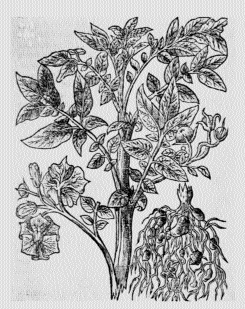
John Gerard, from the frontispiece to the first edition of his Herbal (1597, but here dated 1598), with a potato spray in his left hand.
Whatever about Cavendish bringing potatoes to England, we can be quite certain that he was not responsible for introducing the potato to mainland Europe, since more than eight months before, on 26 January 1588, Clusius had received from the Prefect of Mons, two potato tubers which he duly planted.
An Spáinneach Geal
So when and how did the potato get to Ireland? Rather than looking to England and her naval heroes, we should instead look to Spain. The potato was often referred to as An Spáinneach or An Spáinneach Geal [the white, or kind hearted Spaniard] in its early history. This would suggest a point of origin in Spain itself, or that a Spaniard was responsible for introducing the potato to Ireland. Overseas exchanges with Spain and France involving the export of hides and fish, and imports of wine and cloth were quite substantial. The introduction of the tuber as a curiosity from Spain through Waterford, seems highly plausible. However, given the lack of historical evidence it would be unwise to dismiss the possibility of an introduction from England. Salaman has suggested that the potato was introduced in the last quarter of the sixteenth century. Certainly this date would allow for the potato’s introduction, albeit unlikely by Drake or someone connected with Ralegh. As for an introduction by Ralegh himself, it is a myth, which is still quoted by historians to this day. Although there may be more substance to the suggestion of an introduction by Drake, there is simply no proof. Given the fact that the Spanish were the first Europeans to encounter the potato in the New World, and the first to cultivate it on the European mainland, it should come as no surprise if the Spanish were responsible for bringing the first tubers to our shores. Given that the potato thrived in Ireland from a very early date (but not in Europe), it was probably solanum tuberosum rather than andigena that was introduced. Certainly 1586 would seem to be the earliest feasible date for introduction to Ireland, and 1600 the latest, since the potato was already being grown in John Gerard’s London garden in 1596. Therefore, the appearance of the strange new tuber in Ireland couldn’t have been long delayed.
Tomás O’Riordan tutors in history at University College Cork.
Further reading:
A. Bourke, ‘The Visitation of God’? the potato and the Great Irish Famine (Dublin 1994).
L. Zuckerman, The Potato (London 1999).
R.N. Salaman, The history and Social Influence of the Potato (Cambridge 1949, revised 1985).
W.D. Davidson, ‘The History of the potato and its progress in Ireland’ in Journal of the Department of Agriculture, XXXIII, no.1 (1937).
















